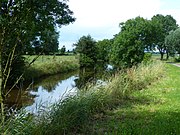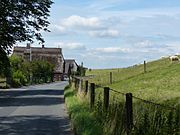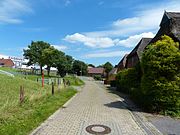Stedingen
Stedingen ( Stedingerland ) is a stretch of land in the Oldenburg Weser marsch and today essentially comprises the area of the municipalities of Lemwerder and Berne in the Wesermarsch district of Lower Saxony . Stedingen was annexed by the expanding county of Oldenburg in the 13th century .
history
In the late Middle Ages and in the early modern period , Stedingen included, in addition to today's area, the former four marsh bailiffs Moorriem , Oldenbrook , Strückhausen and Hammelwarden , the Bailiwick Wüstenlande (called Stedingerwüsten or Wösting), the Osterstade beyond the Weser and probably also the part that already existed at that time of the future Vogteidistrikts Schwei . Since Stedingen was only settled after the end of the Gau constitution, there was probably never a Gau called Stedingen. The area of the area later called Stedingen was part of the Saxon Largau , Nieder-Stedingen des Ammergau in the early and high Middle Ages .
Although Latin-language documents speak of a “populus Stedingorum Rustringiae”, this does not refer to the Saxon Stedingers from the areas south of the Stadland , but rather Frisian Butjadingers and Stadlanders from the Ruestring ancestral lands. There was a spiritual relationship between the Stedingers and their Frisian neighbors insofar as the Stedingers fought for rights that were comparable to those in the neighboring Frisian settlements by the beginning of the 13th century. The term “ peasant republic ” is often used in this context .
Place of the Battle of Altenesch: St. Gallus in Süderbrook
geography
The areas south-west of the Stadland and north-west of the Hunte were formerly called Niederstedingen , the areas south-east of the Hunte Oberstedingen . The present Stedingerland is limited to the former Oberstedingen; it is bounded by the rivers Ochtum , Weser and Hunte and in the south by the (almost completely drained) moor north of Hude and Bookholzberg . Several small rivers, the Berne, Hörspe and Ollen , flow through it and touch the Geestrand in the south. The marshland is fertile and is mainly used as grassland crossed by drainage ditches. The area is at risk of flooding and is protected by dykes along the rivers.
Today's Stedingen covers the southeast of the Wesermarsch district, but protrudes as a landscape a bit into the Oldenburg district , as the Geestrand and thus the Wesermarsch border runs a little south of the border between the districts.
The Weser villages in Stedingen are characterized by shipping. In the 18th and early 19th centuries, the nearby Vegesack was the home port of the Bremen whaling fleet . In the street along the Weser dyke, whalers built their thatched houses, later also captains small villas. The production facilities of three shipyards, Abeking & Rasmussen , Fassmer and Lürssen, are located in the foreland of the dike .
Weser dike in Lemwerder -Ritzenbüttel
See also
Individual evidence
- ^ Wilhelm von Hodenberg: The diocese of Bremen and its districts in Saxony and Friesland . Capaun-Karlowa, Celle 1858, p. 36
- ^ Wilhelm von Hodenberg: The diocese of Bremen and its districts in Saxony and Friesland . Capaun-Karlowa, Celle 1858, p. 43
- ^ TD Wiarda: Asega book - an old Frisian code of law . Verlag Friedrich Nicolai, Berlin / Stettin 1805, p. LXXXIV. Facsimile of the original edition
- ↑ http://www.bauernkriege.de/Bauern Republik.html
literature
- Hermann A. Schumacher, The Stedinger . Contribution to the history of the Weser marshes, Bremen 1865
- Gerold Meiners, Stedingen and the Stedinger , Bremen 1987
- Heinz B. Maaß, news from old Stedigen . Small Stedinger home library. Stedinger Verlag, Lemwerder 1990
- Heinrich Schmidt : Stedingen, Stedinger . In: Lexicon of the Middle Ages (LexMA). Volume 8, LexMA-Verlag, Munich 1997, ISBN 3-89659-908-9 , Sp. 83.
- Jens Schmeyers, The Stedinger Peasant Wars . True events and historical considerations. In memory of the Battle of Altenesch in 1234. Stedinger Verlag, Lemwerder 2004
- Bernd Ulrich Hucker : Sannau 880 years. On the early history of a Stedinger village . Bremen 2019. ISBN 978-3-938275-97-9
Web links
- Stedingerland . In: Meyers Konversations-Lexikon . 4th edition. Volume 15, Verlag des Bibliographisches Institut, Leipzig / Vienna 1885–1892, p. 253.
- Stedinger Online Chronicle
- Meister Eckhart and his time - Bauer - Stedinger






